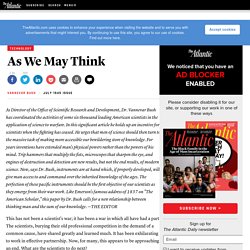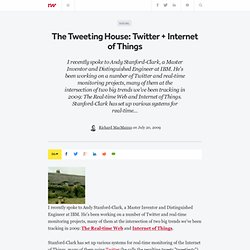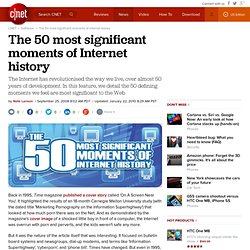

As We May Think - The Atlantic (July 1945) As Director of the Office of Scientific Research and Development, Dr.

Vannevar Bush has coordinated the activities of some six thousand leading American scientists in the application of science to warfare. In this significant article he holds up an incentive for scientists when the fighting has ceased. He urges that men of science should then turn to the massive task of making more accessible our bewildering store of knowledge. For years inventions have extended man's physical powers rather than the powers of his mind. Trip hammers that multiply the fists, microscopes that sharpen the eye, and engines of destruction and detection are new results, but not the end results, of modern science. This has not been a scientist's war; it has been a war in which all have had a part. For the biologists, and particularly for the medical scientists, there can be little indecision, for their war has hardly required them to leave the old paths.
There is a growing mountain of research. The Tweeting House: Twitter + Internet of Things. I recently spoke to Andy Stanford-Clark, a Master Inventor and Distinguished Engineer at IBM.

He's been working on a number of Twitter and real-time monitoring projects, many of them at the intersection of two big trends we've been tracking in 2009: The Real-time Web and Internet of Things. Stanford-Clark has set up various systems for real-time monitoring of the Internet of Things, many of them using Twitter (he calls the resulting tweets "tweetjects"). One example got a bit of mainstream media coverage lately: a house that uses Twitter to monitor its energy consumption. As Rory Cellan-Jones from the BBC reported recently, Stanford-Clark has installed sensors on a number of household objects - such as electricity meters and windows. From this he can monitor lighting, heating, temperature, phone and water usage. He's also now hooked up his house sensors to a Twitter account: andy_house (it's a private account, so requires Andy's approval before you can follow it). The 50 most significant moments of Internet history - Crave at C.
Back in 1995, Time magazine published a cover story called 'On A Screen Near You'.

It highlighted the results of an 18-month Carnegie Mellon University study (with the dated title 'Marketing Pornography on the Information Superhighway') that looked at how much porn there was on the Net. And as demonstrated by the magazine's cover image of a shocked little boy in front of a computer, the Internet was overrun with porn and perverts, and the kids weren't safe any more. But it was the nature of the article itself that was interesting. It focused on bulletin board systems and newsgroups, dial-up modems, and terms like 'Information Superhighway', 'cyberporn', and 'phone bill'.
Times have changed. We decided to plough the history of the entire Internet, from the roots of its underlying technology, to the Web properties that helped it explode, the litigation it endured on the way and disasters companies have suffered as a result of the Net's popularity.